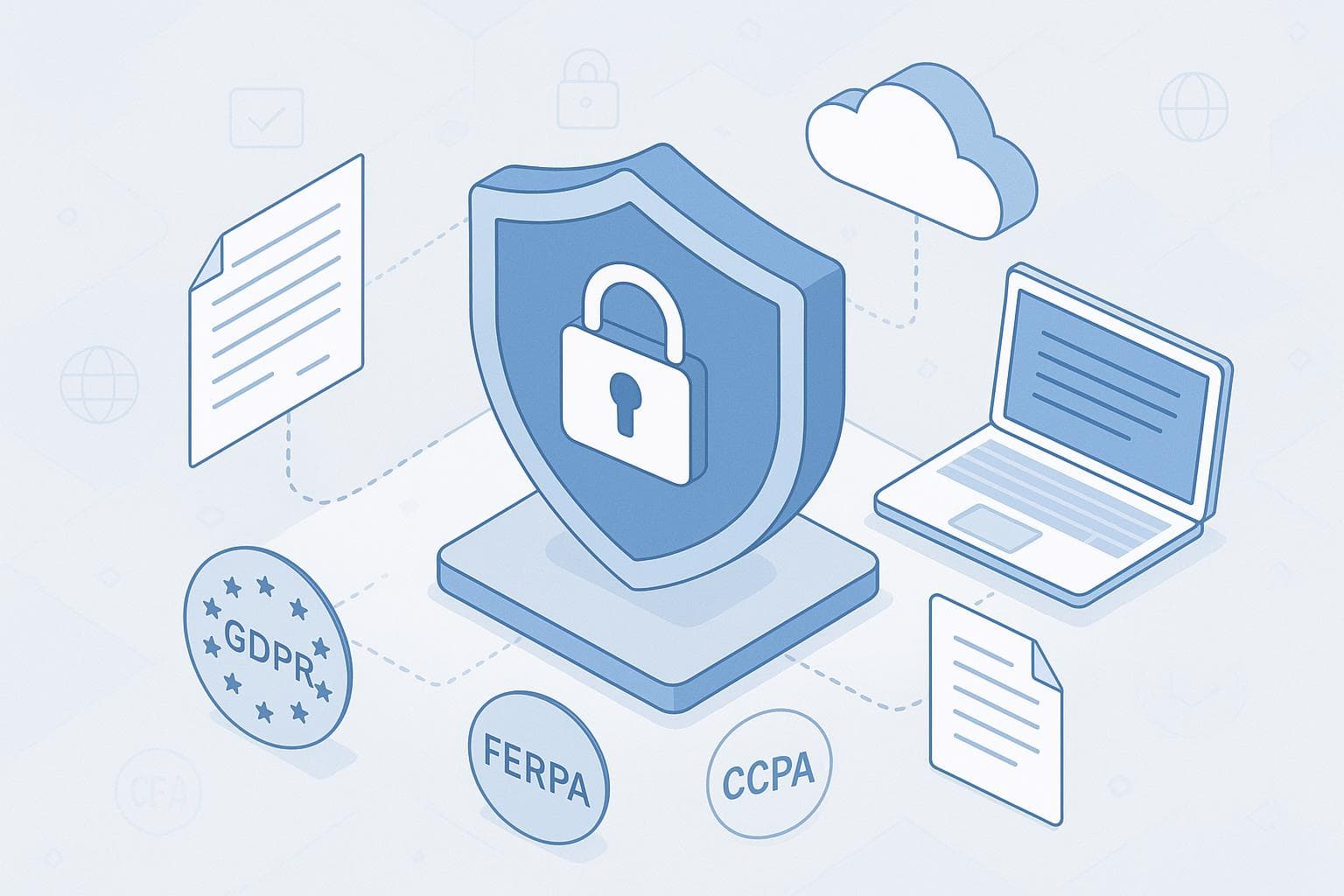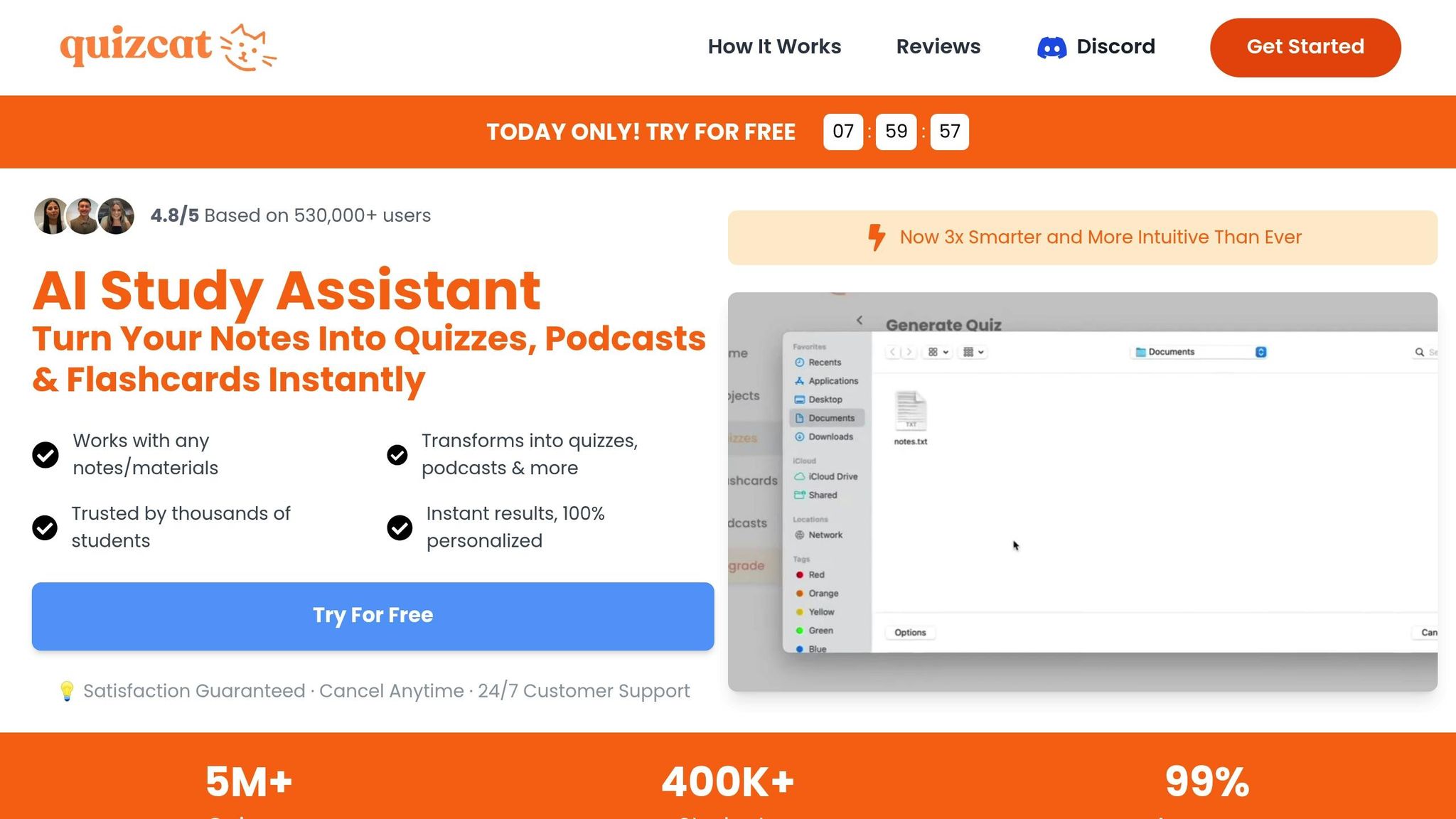
LTI Data Privacy: Best Practices for Compliance
Protecting student data in Learning Tools Interoperability (LTI) systems is critical. Here's what you need to know:
- Top Risks: Data leaks, unauthorized access, insecure storage, and improper third-party sharing.
- Key Regulations: GDPR, FERPA, and CCPA set strict rules for data handling, consent, and security.
- Best Practices: Use strong encryption (AES-256, TLS 1.3), limit data collection, and enforce vendor security standards.
- Consent Management: Provide clear opt-in controls, easy withdrawal options, and robust age verification for minors.
- Monitoring & Response: Regular audits, breach response protocols, and compliance tracking are essential.
Platforms like QuizCat AI show how strong privacy measures - like encryption, consent tools, and secure storage - can protect users while enhancing functionality. By prioritizing privacy, you safeguard data, comply with laws, and build trust.
Quick Comparison of Key Privacy Regulations
| Regulation | Key Requirements | Penalties |
|---|---|---|
| GDPR | Consent, data minimization, breach notification | Up to €20M or 4% of revenue |
| FERPA | Parental/student access, sharing restrictions | Loss of federal funding |
| CCPA | Data disclosure, deletion rights, opt-out options | $7,500 per violation |
Start with encryption, consent controls, and regular audits to protect your LTI system today.
1EdTech Data Privacy Rubric (in 5 Minutes)

Privacy Laws Affecting LTI
Navigating the privacy regulations that impact Learning Tools Interoperability (LTI) implementations can be challenging, as various laws dictate how educational technology providers must handle sensitive student data.
GDPR, FERPA, and CCPA Requirements
Three key regulations - GDPR, FERPA, and CCPA - set the foundation for privacy compliance in LTI systems. Each has specific rules that influence how platforms manage user information:
| Regulation | Key Requirements | Penalties for Non-compliance |
|---|---|---|
| GDPR | Requires explicit consent for data collection, protocols for international data transfers, the right to erasure, and breach notification within 72 hours | Fines up to €20 million or 4% of annual global revenue |
| FERPA | Mandates written permission for sharing identifiable information, provides parent/student access rights, and includes opt-out options for directory information | Loss of federal funding for non-compliant institutions |
| CCPA | Obligates platforms to disclose data collection practices, honor requests to delete personal data, and provide opt-out options for data sales | Fines of up to $7,500 per intentional violation |
Since the Schrems II ruling, LTI providers must adopt alternative methods for international data transfers. Compliance also demands careful adherence to principles like data minimization and purpose limitation. This means platforms need to clearly define and document how student data will be used for specific educational purposes. Beyond these international standards, platforms operating in the U.S. must also align with state-specific privacy laws.
U.S. Privacy Laws for LMS Platforms
In addition to global frameworks, U.S. laws introduce further requirements for Learning Management System (LMS) platforms. Several state-level regulations add layers of compliance:
- Virginia's Consumer Data Protection Act (CDPA) focuses on consumer rights, including access to and correction of personal data.
- Colorado's Privacy Act (CPA) includes protections against user profiling.
- Connecticut's Data Privacy Act (CTDPA) offers enhanced protections for children's data.
- Illinois' Biometric Information Privacy Act (BIPA) requires explicit consent for collecting biometric data.
To meet these regulations, strong encryption practices are a must. LTI providers should ensure secure data transmission using TLS 1.2 or higher and store data with AES-256 encryption. Regular audits and updates to data handling processes are critical to staying compliant.
Data Security Methods for LTI
Meeting regulatory requirements is only part of the challenge when it comes to protecting Learning Tools Interoperability (LTI) systems. Effective security measures are crucial to safeguarding sensitive educational data and ensuring compliance.
Data Encryption Standards
Encryption is a cornerstone of data security. Here’s what a strong encryption framework should include:
| Component | Requirement |
|---|---|
| Transit Encryption | Use TLS 1.3 to secure data in transit |
| Data at Rest | Apply AES-256 for stored data |
| Key Management | Centralize key lifecycle management |
| Backup Encryption | Ensure backups are encrypted and secure |
In addition to encryption, reducing the volume of collected data is a practical way to lower the risk of breaches.
Data Collection Limits
Limiting the collection of data helps minimize exposure to potential risks. To achieve this, organizations should:
- Perform regular audits to identify and eliminate unnecessary data collection.
- Enforce strict controls to prevent unauthorized data gathering.
- Collect only essential academic identifiers and apply de-identification techniques when possible.
While controlling data collection is essential, ensuring that vendors meet security standards is just as important.
Vendor Security Standards
Working with vendors requires careful oversight to ensure compliance with security protocols. Here are some key security requirements and how to verify them:
| Security Requirement | Verification Method |
|---|---|
| SOC 2 Type II Certification | Review certification documents |
| Penetration Testing | Conduct independent assessments |
| Vulnerability Scanning | Use automated scanning tools |
| Security Incident Response | Perform tabletop response drills |
Security teams should keep a close eye on LTI systems, particularly when it comes to activities involving privileged access or data exports. To maintain strong vendor management practices, organizations should:
- Schedule regular security audits, using questionnaires, documentation reviews, and contractual checks.
- Include right-to-audit clauses and establish security-specific service level agreements in vendor contracts.
- Conduct periodic reviews to verify ongoing compliance.
Ongoing measures such as vulnerability assessments, configuration audits, and penetration tests are essential to keeping systems secure and compliant over time.
Privacy Controls and Consent
Effective privacy controls and consent management are key for ensuring LTI compliance and safeguarding user data. Beyond meeting security and regulatory standards, these measures rely on clear consent processes and robust age verification systems to maintain privacy protections.
Consent System Design
Creating an efficient consent system means finding the right balance between user experience and regulatory compliance. This can be achieved through detailed, user-friendly opt-in controls.
| Consent Component | Implementation Requirement | Compliance Benefit |
|---|---|---|
| Data Usage Explanation | Provide clear, easy-to-understand descriptions | Ensures users give informed consent |
| Granular Controls | Allow separate opt-ins for different data uses | Aligns with GDPR requirements |
| Withdrawal Process | Enable one-click consent revocation | Supports user rights |
| Consent Records | Maintain detailed logs of user consent | Demonstrates regulatory compliance |
To promote transparency, users should be informed at the time of data collection about:
- The specific data being collected
- Its intended use
- Retention duration
- Who will have access to the data
For platforms catering to minors, additional safeguards like age-specific verification must be implemented.
COPPA Age Verification
Complying with COPPA involves creating secure age verification and parental consent systems that prioritize both safety and usability.
| Verification Method | Implementation Approach |
|---|---|
| Credit Card Verification | Use a single authorization without charging the card |
| Electronic Consent Forms | Implement a digital signature system |
| Video Verification | Conduct video conferencing with a parent or guardian |
| School District Integration | Facilitate bulk verification through an administrative portal |
The verification process typically includes:
- Age Screening: Use a simple age gate to identify users under 13 and direct them to a parental consent workflow.
- Parental Verification: Provide multiple options for parental verification and log all relevant details.
- Ongoing Management: Automate tracking of consent expiration dates and send timely renewal notifications.
To protect sensitive information, the system must maintain secure records and enforce proper security protocols. Regular usability testing with diverse age groups can help identify potential issues, ensuring the system remains user-friendly while meeting compliance requirements.
sbb-itb-1e479da
Security Monitoring and Response
Once solid data security measures are in place, the next step is ensuring continuous monitoring and swift incident response. These elements play a critical role in maintaining data privacy compliance for LTI systems.
Breach Response Protocol
An effective breach response protocol is the backbone of handling security incidents. It clearly defines roles and outlines the steps necessary to detect, contain, investigate, notify, and recover from breaches. For instance, GDPR requires organizations to notify supervisory authorities within 72 hours if a breach threatens user rights. Key steps in the response process include:
- Activating the incident response team as soon as a breach is detected
- Isolating impacted systems to prevent further data loss
- Documenting the incident details, including affected data and the root cause
- Notifying regulatory bodies and affected individuals in line with legal requirements
- Implementing corrective actions to restore systems and prevent recurrence
Organizations must keep detailed records of the breach, including its scope, the types of data compromised, affected individuals, containment efforts, and all related communications. This structured approach ensures compliance and supports continuous monitoring efforts.
"The average time to identify and contain a data breach is 277 days, with U.S. organizations facing an average cost of $9.48 million per incident."
- IBM Cost of a Data Breach Report 2023
Compliance Tracking
Addressing a breach is only part of the equation. Ongoing monitoring is crucial to ensure security controls remain effective over time. Automated tools can scan for security violations, perform vulnerability assessments, and check system configurations against established policies. Monitoring user activity and access controls can also help spot unauthorized access or other potential risks.
Security Information and Event Management (SIEM) solutions are particularly valuable. They collect logs from various sources, enabling real-time threat detection and simplifying compliance tracking. To ensure security measures are working as intended, organizations should combine internal reviews with external audits. These assessments evaluate factors like policy enforcement, technical safeguards, staff readiness, incident response capabilities, and documentation practices.
Language Testing International sets a strong example by employing a multi-tenant architecture, assigning unique encryption codes to each client, and using TLS 1.2+ for secure data transmission. This approach not only strengthens data isolation but also simplifies the process of containing breaches.
Regular security assessments - through both internal checks and external audits - are essential for identifying weaknesses and improving overall security practices. They ensure an organization remains vigilant and prepared for emerging threats.
QuizCat AI Privacy Features

QuizCat AI prioritizes privacy and data protection, combining secure practices with personalized learning. The platform ensures user data is handled responsibly while maintaining top-notch functionality.
Smart Data Collection
QuizCat AI adopts a "less is more" approach to data collection. By focusing on data minimization, it limits the collection of personal information and uses a multi-tenant architecture with encryption to separate user data effectively. The system identifies essential academic concepts without retaining unnecessary personal identifiers, relying on anonymized learning patterns to create customized study materials. This careful handling of data ensures both privacy and effective content delivery.
Content Security Measures
To safeguard user-uploaded materials, QuizCat AI employs multiple layers of security. Data transferred between users and the platform is protected using Transport Layer Security (TLS 1.2+), ensuring a secure channel for uploads and interactions. For data stored on the platform, AES-256 encryption provides robust protection.
Key security measures include:
- Access Control Systems: Role-based authentication restricts data access to authorized personnel, with regular permission reviews to maintain appropriate access levels.
- Intellectual Property Protection: Integrated plagiarism detection tools help prevent unauthorized use of copyrighted materials, and content-specific encryption ensures academic materials remain secure. Additionally, uploaded content is automatically deleted after a set period or upon user request.
Privacy Standards Compliance
QuizCat AI aligns with global privacy standards to ensure secure data handling. The platform includes consent management tools that allow users to control their data preferences easily. For international data transfers, it adheres to safeguards like the standard contractual clauses outlined by GDPR. These measures, combined with advanced encryption and consent controls, create a comprehensive data privacy framework.
| Privacy Feature | Implementation |
|---|---|
| Data Encryption | AES-256 for stored data; TLS 1.2+ for transfers |
| Access Controls | Role-based authentication with regular reviews |
| Consent Management | Granular tools with easy withdrawal options |
| Compliance Monitoring | Quarterly internal audits and annual external assessments |
| Data Retention | Automated deletion systems with user control |
To further enhance security, a dedicated incident response team monitors the platform around the clock. In the event of a breach, the team follows strict protocols to detect, address, and notify users within the 72-hour window required by GDPR.
Conclusion
Key Privacy Guidelines
Protecting data privacy in LTI systems is all about finding the right balance between security and usability. Key elements like strong encryption, clear consent processes, and routine security audits lay the groundwork for effective privacy protection. Features such as role-based access controls and data minimization ensure that unauthorized access is blocked while keeping the platform running smoothly.
Platforms that make privacy a priority not only safeguard user data but also build trust, which in turn encourages adoption. For instance, QuizCat AI's dedication to privacy has earned it an impressive 4.8/5 rating from over 530,000 users. These practices don't just protect data - they also enhance user engagement and contribute to the platform's overall success.
Privacy and Platform Success
The connection between robust privacy practices and platform success is clear in both user feedback and engagement metrics. One satisfied user shared:
"I was drowning in notes before I found this tool. Now, it turns everything into flashcards, quizzes, and even podcasts! Studying has never been this easy. 🚀 Highly recommend!"
A strong foundation in privacy creates a secure space where innovation can thrive while safeguarding user interests. This is especially critical in educational technology, where sensitive student information must be handled with care. The results of these privacy measures show up in both user satisfaction and platform reliability, as illustrated below:
| Privacy Practice | Platform Benefit | User Impact |
|---|---|---|
| Data Encryption | Enhanced Security | Increased Trust |
| Consent Management | Regulatory Compliance | Greater User Control |
| Regular Audits | Risk Mitigation | Improved Stability |
| Incident Response | Quick Issue Resolution | Reliable Service |
FAQs
What are the main differences between GDPR, FERPA, and CCPA, and how do these regulations affect LTI-based learning systems?
GDPR, FERPA, and CCPA: How They Impact LTI-Based Learning Systems
When it comes to protecting personal data, GDPR, FERPA, and CCPA are major regulations that play distinct roles. Their scope and application differ, especially in the context of LTI-based learning systems.
- GDPR (General Data Protection Regulation) focuses on safeguarding the personal data of individuals in the European Union. It emphasizes principles like user consent, data minimization, and transparency. For LTI systems, this means implementing strict data protection measures and ensuring clear, user-friendly consent processes for EU-based users.
- FERPA (Family Educational Rights and Privacy Act) is a U.S. law that prioritizes the privacy of student education records. LTI platforms must ensure student data is securely stored and only accessible to authorized individuals, maintaining compliance with FERPA requirements.
- CCPA (California Consumer Privacy Act) provides California residents with rights over their personal data, such as access, deletion, and the ability to opt out of data sharing. For LTI providers, compliance involves enabling these rights and ensuring California users can easily exercise them.
For LTI-based systems, staying compliant with these regulations requires robust privacy policies, secure data handling protocols, and features that respect the rights of users under each law.
What are the best practices for LTI providers to manage user consent and ensure compliance with data privacy regulations?
To manage user consent effectively and stay compliant with data privacy regulations, LTI providers should focus on being clear and user-focused. Start by explaining exactly what data is collected, why it's needed, and how it will be used. Use plain, easy-to-understand language in privacy policies and consent forms to avoid confusion.
Offer granular consent options so users can decide what information they’re comfortable sharing. Keep your systems updated to meet changing regulations like GDPR or CCPA, and make it simple for users to update or withdraw their consent whenever they choose. On top of that, prioritize strong security measures to safeguard user data and build trust.
These steps not only ensure compliance but also create a smoother, more user-friendly experience.
What are the best practices for ensuring third-party vendors on LTI platforms comply with data privacy and security standards?
To ensure that third-party vendors working with LTI platforms meet data privacy and security requirements, consider these key steps:
- Thoroughly assess vendors: Review their security policies, certifications, and adherence to regulations like FERPA, GDPR, or CCPA.
- Define responsibilities in contracts: Clearly state data protection obligations, including secure storage, access controls, and breach response measures.
- Regular monitoring and audits: Continuously evaluate vendor practices and security protocols to ensure they remain compliant.
Taking these measures helps protect sensitive information and uphold trust in your LTI-based learning platform.
